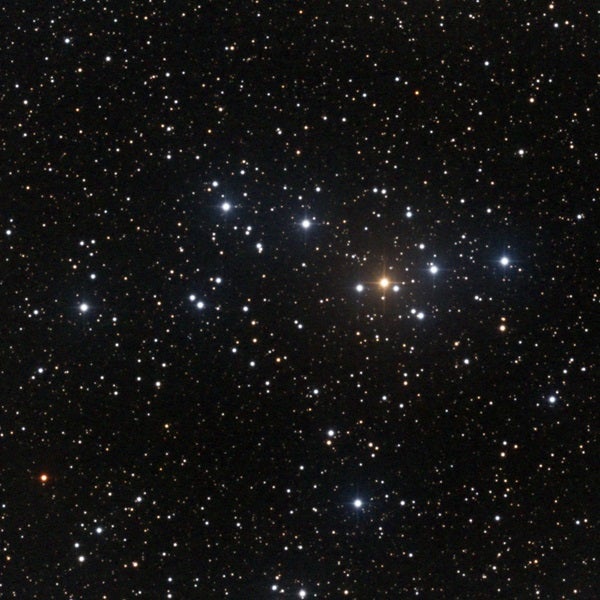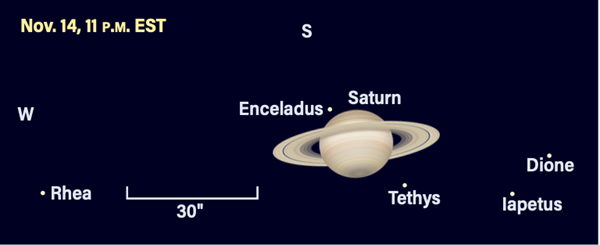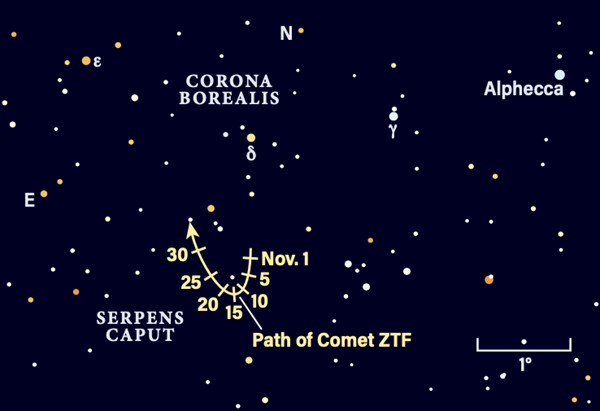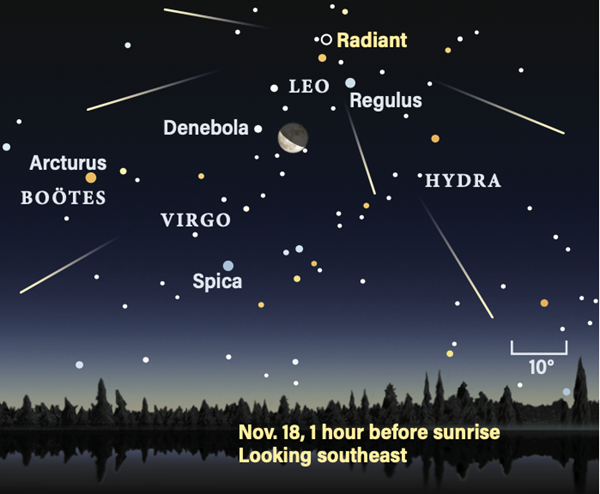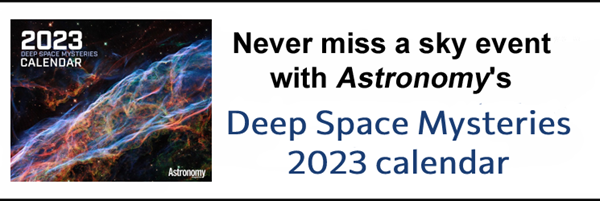Friday, November 11
The Moon passes 2° north of Mars at 9 A.M. EST. By three hours after sunset, the pair is once again in the sky, with magnitude –1.5 Mars sitting between the two endpoints of Taurus the Bull’s horns, Elnath and Alheka. The Moon is now about 7.2° northeast of the Red Planet, pulling slowly away and moving deeper into Gemini as the night continues.
Cast your gaze to their upper left (northwest) to enjoy the open cluster Trumpler 2, which lies about 1.7° northwest of magnitude 3.8 Miram Eta [η] Persei. This is an excellent binocular or small scope target, great for beginners. Several of the young grouping’s blue-hued stars are visible through 7x binoculars, while a standout star near its center, cataloged as HD 16068, is markedly orange-red.
Sunrise: 6:40 A.M.
Sunset: 4:47 P.M.
Moonrise: 6:55 P.M.
Moonset: 9:58 A.M.
Moon Phase: Waning gibbous (90%)
*Times for sunrise, sunset, moonrise, and moonset are given in local time from 40° N 90° W. The Moon’s illumination is given at 12 P.M. local time from the same location.
Saturday, November 12
Asteroid 27 Euterpe reaches opposition in Aries at 11 A.M. EST. In the nighttime sky, the stony main-belt world is about 20° high in the east two hours after sunset and an hour before moonrise, making this the perfect time to catch it.
Euterpe sits about 4° east of Uranus in the sparse southeastern regions of the Ram. The ice giant glows at magnitude 5.7, while Euterpe is a fainter magnitude 8.8. Still, both should show up in binoculars or a small scope, though not in the same field of view unless yours is particularly wide. Additionally, Euterpe sits about 15′ northeast of a small, triangular set of three faint field stars, which may make it a bit easier to pick out.
Some 13° northeast of the dim pair is the bright Pleiades open cluster, one of the jewels of Taurus the Bull. This cluster spans more than 100′ and contains hundreds of stars, though many are too faint to see. With the naked eye, most people can pick out six or seven bright stars; binoculars or a small scope — or your finder scope — will show many more. Avoid high magnifications here, as it will only limit the cluster members you can see.
Sunrise: 6:42 A.M.
Sunset: 4:46 P.M.
Moonrise: 7:46 P.M.
Moonset: 10:52 A.M.
Moon Phase: Waning gibbous (83%)
Sunday, November 13
An hour before sunrise, Leo the Lion is high in the eastern sky. The big cat’s brightest star, Regulus, glows at magnitude 1.4 and marks the end of the backwards question mark-shaped asterism the Sickle.
Pull out 12x or greater binoculars — or a small scope — and you may pick out an 8th-magnitude companion just 3′ northwest of Regulus’ bright light. Though this is a large separation and the stars should be easy to split, the fainter star is so much dimmer than Regulus that it’s easy to lose in the blazing luminary’s glare. Regulus is some 150 times brighter than our Sun, just over 3 times as massive, and roughly 4 times as wide — though some of its girth is due to the fact that Regulus is an extremely fast-rotating star. It spins once every 16 hours; by contrast, the Sun’s equator, which rotates faster than its poles, takes 24 days to make a complete revolution.
Starting back at Regulus, slide down about 2° due south. You’ll land on 4th-magnitude 31 Leonis, whose golden-yellow light contrasts nicely with Regulus’ blue-white glow. The two might look like a binary through binoculars, but they are not physically related in space.
Sunrise: 6:43 A.M.
Sunset: 4:45 P.M.
Moonrise: 8:43 P.M.
Moonset: 11:40 A.M.
Moon Phase: Waning gibbous (75%)
Monday, November 14
The Moon reaches apogee, the farthest point from Earth in its orbit, at 1:40 A.M. EST. At that time, our satellite is 251,606 miles (404,920 kilometers) away.
The beautiful ringed planet Saturn starts these fall evenings some 30° high in the southern sky, sinking slowly over the next few hours to set around 11 P.M. local time. Glowing at magnitude 0.6, it is located about 1° northeast of Iota (ι) Capricorni and 5° west of Deneb Algedi.
Tonight, Saturn’s largest moon, magnitude 8.5 Titan, sits 2′ east-southeast of the planet. Several fainter, closer-in satellites cluster around the rings: Rhea, Tethys, and Dione are all 10th magnitude and sit inside Titan’s orbit. Rhea is currently 1′ west of Saturn, while the other two moons are nearer to the disk and rings.
But there’s a visitor in the field of view: 11th-magnitude Iapetus, which usually resides far east or west of the planet, is tonight just 35″ northeast of Saturn’s disk. The moon passed through superior conjunction yesterday. You can use slightly brighter Dione to point the way — Iapetus is only 10″ southeast of Dione this evening. Over the coming days, Iapetus will move farther away again and its darker hemisphere will also rotate toward us, dimming the moon further to about magnitude 12.
Sunrise: 6:44 A.M.
Sunset: 4:44 P.M.
Moonrise: 9:44 P.M.
Moonset: 12:19 P.M.
Moon Phase: Waning gibbous (67%)
Tuesday, November 15
With moonrise delayed until late this evening, conditions are perfect for observing Comet C/2022 E3 (ZTF) shortly after sunset. Still around 10th to 11th magnitude, ZTF requires at least a 6-inch scope and clear, dark skies, so do your best to get away from any low-lying light pollution.
The comet is making a slow curve through Serpens Caput this month, just south of Corona Borealis. Tonight, ZTF is just over 1.5° due south of magnitude 4.6 Delta (δ) Coronae Borealis in the Northern Crown. The comet is essentially at the turning point in its curve and will now start moving slowly north and slightly east as November continues.
Once you’ve found the faint fuzzball, bump up your magnification to 100x or more. Look for a well-defined southern flank and a short, stubby fan of a tail extending slightly northward. Through the rest of the year, the comet should continue to brighten. Astronomers are hoping it will put on a good show in early 2023, perhaps as the best comet of the year.
Sunrise: 6:45 A.M.
Sunset: 4:43 P.M.
Moonrise: 10:45 P.M.
Moonset: 12:53 P.M.
Moon Phase: Waning gibbous (58%)
Wednesday, November 16
Last Quarter Moon occurs at 8:27 A.M. EST. Early risers will now have a chance to enjoy our satellite as it rules the predawn skies.
Night owls will miss our Moon; however, they can instead enjoy the fast-moving moons of Jupiter. The magnitude –2.7 planet is in Pisces, easy to find with the naked eye. But you’ll need a telescope to watch two of its satellites transit the disk tonight, so pull out your scope and get settled in for the show.
Things kick off around 8:30 P.M. EST, when Europa crosses onto the disk in a transit. The larger, brighter moon Ganymede is not far behind. Europa is nearly off the west side of the disk when its shadow finally joins the show around 10:45 P.M. EST, appearing slightly northwest of Ganymede. That large moon moves in front of Jupiter around 10:50 P.M. EST, just minutes after Io has popped into view northeast of the disk following an occultation, having crossed out of Jupiter’s dark shadow and once more into sunlight.
Europa’s shadow slightly leads Ganymede across the planet, keeping ahead the whole time. Europa leaves the disk around 11 P.M. EST, its shadow following around 1:10 A.M. EST on the 17th (just after midnight in the Central time zone and still late on the 16th in western time zones). Ganymede slips off the disk around 1:40 A.M. EST on the 17th, but its own shadow won’t appear over the cloud tops until the planet has set for much of the U.S., around 12:30 A.M. PST on the 17th.
Sunrise: 6:46 A.M.
Sunset: 4:43 P.M.
Moonrise: 11:48 P.M.
Moonset: 1:21 P.M.
Moon Phase: Waning crescent (48%)
Thursday, November 17
Dark evening skies continue as the crescent Moon wanes, so let’s enjoy a beautiful globular cluster in Aquarius the Water-bearer tonight. M2 is a rich, compact globular about 4.5° due north of 3rd-magnitude Sadalsuud, also known as Beta (β) Aquarii. The cluster is still nearly 50° high in the south two hours after sunset. If your eyes are sharp and your observing site dark, you may even spot this magnitude 6.5 globular without optical aid, appearing as a faint, cloudy glow.
But train a telescope on this showpiece and myriad stars will pop out. The cluster’s densely packed center gives way to busy outskirts. M2’s core spans only about 20″, but the cluster’s full extent is about 16′ across. Many observers think that core looks not quite round, but slightly oblate. Take your time enjoying the view, as the region won’t set until just before midnight.
The Leonid meteor shower peaks late tonight, but the best time to catch its meteors will be early tomorrow morning, so keep reading.
Sunrise: 6:47 A.M.
Sunset: 4:42 P.M.
Moonrise: —
Moonset: 1:46 P.M.
Moon Phase: Waning crescent (39%)
Friday, November 18
Although the Leonids technically peaked late last night, the radiant in Leo the Lion is highest in the hours before dawn this morning. Look southeast in the hour or two before sunrise to again find bright Regulus. The Leonids’ radiant sits 10° north of this star, or about 2° southwest of 3rd-magnitude Adhafera (Zeta [ζ] Leonis). Once you’ve found the rough location of the radiant, cast your gaze some ways away from it — this is how you’ll spot meteors with longer trains.
The Leonids come from dust left behind by passes of Comet 55P/Tempel-Tuttle through the inner solar system. The expected shower rate at maximum is about 10 meteors per hour, though the waning Moon is also in Leo and will certainly interfere a bit. However, some scientists estimate the Leonids may experience an outburst or two this year, potentially kicking up the rate as high as 50 to 250 meteors per hour — so it might still be worth stepping outside to check the skies this morning. And even if rates aren’t high, bright shower members are still stunning to see streaking across the sky.
Sunrise: 6:49 A.M.
Sunset: 4:41 P.M.
Moonrise: 12:50 A.M.
Moonset: 2:09 P.M.
Moon Phase: Waning crescent (29%)

